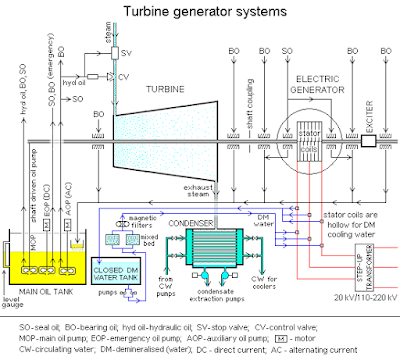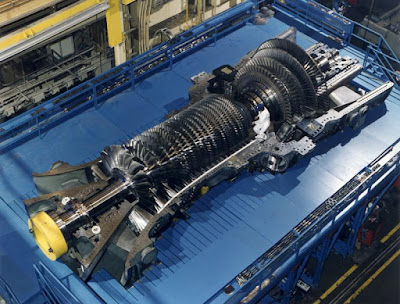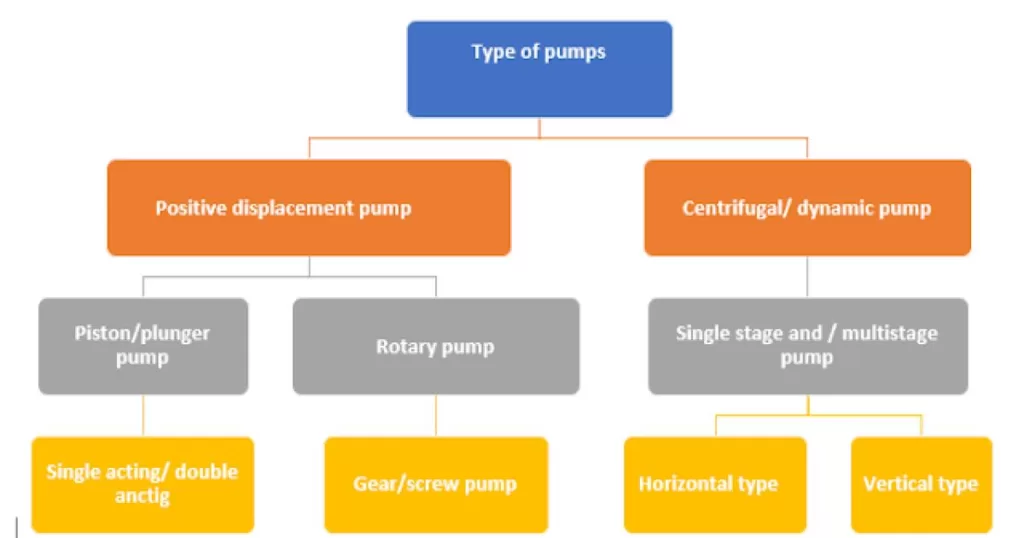What is Turbine?
The turbine is a mechanical device which converts the kinetic energy into mechanical power by the help of buckets and blades. It is also called energy-producing devices. When fluid enters through the nozzle and strikes the bucket or blade, then the rotor is started rotating because blades or buckets are fixed on the rotor. and the rotor is coupled with other equipment like a multistage pump, compressors, and generator, etc.
Block diagram of a steam turbine
Type of turbines
The turbine is categorized by four bases point
On the type of working
1.Steam turbine
2.Hydraulic turbine
3.Gas turbines
The direction of fluid flow for action
1.Axial flow
2.Vertical flow
On the action of the fluid
1.Velocity compounding
2.Pressure compounding
3.Velocity and pressure compounding
On the principle of working, there are three types of turbine
1.Impulse (Pelton wheel)
2.Reaction (Francis and Kaplan)
3.Gravity type
Impulse
This type of turbine is driven by very fast velocity jet fluids. Direct strike on the bucket and the expansion of the steam takes place and shaft stars rotate. In the impulse type turbine, the clearance between the rotating and stationary surface is greater than the reaction type turbines.
Reaction
The reaction turbine is fully immersed with fluid with fully enclosed pressure casing. in reaction turbine steam flow by guide mechanisms and then flow through the rotating blades.
Gravity type
It is driven by the weight of water entering the top of the turbine and falling to the bottom where it is released.
Steam turbine
The steam turbine is operating with a high steam pressure jet that converts the kinetic energy of the system into mechanical power. The steam turbine is always considered as a prime mover. Steam turbine is mostly used in power sectors like power plants, refinery, petrochemical, power generations, and other services.
It is also used to drive critical equipment turbomachinery likes compressor, generators, multistage pumps another rotating equipment.
Advantages and disadvantages of the steam turbines
Advantage
- It has high efficiency as compared to other turbines and steam engines.
- It is run with high rotational speed, and it can be used for a wide range of operating speeds.
- The flywheel is not required for continuation power output.
- The power given to the machinery is uniform it is available in a variety of equipment like low speeds, high speeds.
- Vibration is very less due to less rubbing part use in equipment.
- Comparatively low initial costs are less expensive for maintenance.
- It is available in very high overload capacities.
- Steam is free of oil contamination and no internal lubrication is needed.
Disadvantage
- The installation cost is very high, it is more expensive than the other turbine.
Internal and external part list
The internal and external parts of the steam turbine buckets, blades, pressure casing, rotors runners,’ nozzles, spray nozzles, velocity jet nozzles, bearings, bearing housing, seals, shaft seal, control valves.
The main external part of the steam turbine
Steam strainer steam
Steam strainer install in the unit lines suction line of the steam turbine to prevent the foreign materials being carried out into the turbine with steam install very close to throttling valves
Throat valve
The function of the throttle valve age to control the system entering the steam turbine throttling and acting as a closing emergency valve. Total balls should we maintain very carefully and always lubricating its part otherwise it could not be work properly.
Operating governors
emergency governors auxiliary lube oil pump evolving systems earrings like thirst wearing sir tilting pad bearings main bearings soft packing shaft coupling turbine wheels pressure and temperature gauges.
Question about turbines and steam turbines
What is the function of the turbine?
The function of the steam turbine is to generate the power and other forms of power (rotating) by utilizing the fluid-like as a liquid, gas, steam, etc.
How does a steam turbine work?
The steam turbine is work by using the steam, the high-temperature steam with very high-pressure jet directly strike to spinning rotor blades through the nozzle. The kinetic energy of the steam is converted into the mechanical energy (rotating) of the turbine. The generated rotary motion is particularly suited for a drive. The other rotating equipment like pumps, compressors, the generator is used for electrical power generation systems and other activity. Where the steam turbine is coupled with equipment’s live pump compressor are power generators.
Where is the turbine used?
1.Power generation
2.Refinery, petrochemical
3.Food processing
4.Gas processing unit
5.West to energy
What different types of turbines?
Type or classification of a steam turbine are following
On the based of Nature
1.Impulse
2.Reaction
On the base of steam supply and exhaust condition
1.Reheat
2.Mixed pressure
3.Condensing and non-condensing
By shaft position
1.Horizontal
2.Vertical
The direction of steam flow
1.Axial flow
2.Radial flor
3.Tangential flow
How many types of reaction turbines?
Mainly two types of a reaction turbine, Kaplan and Francis
How many types of impulse turbine?
There are three types of impulse turbine Pelton Turgo and Crossflow.
There are some articles mentioned below which you can also read.







